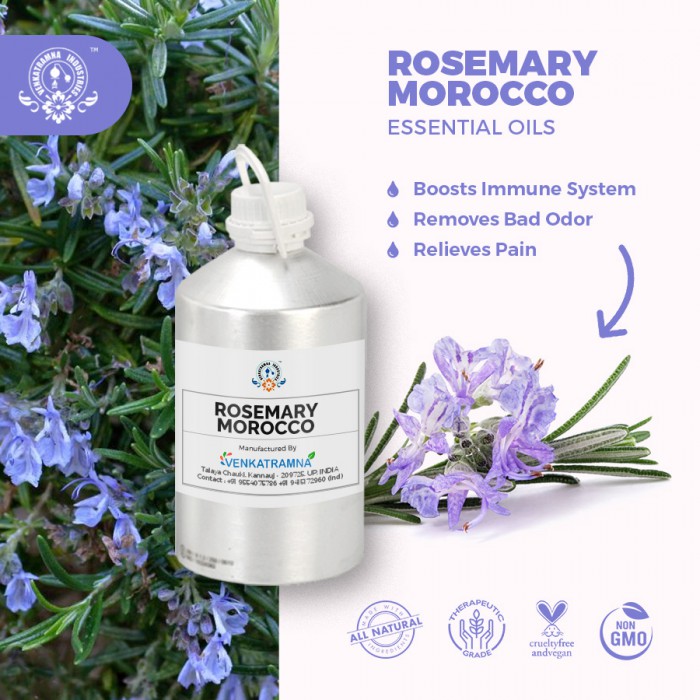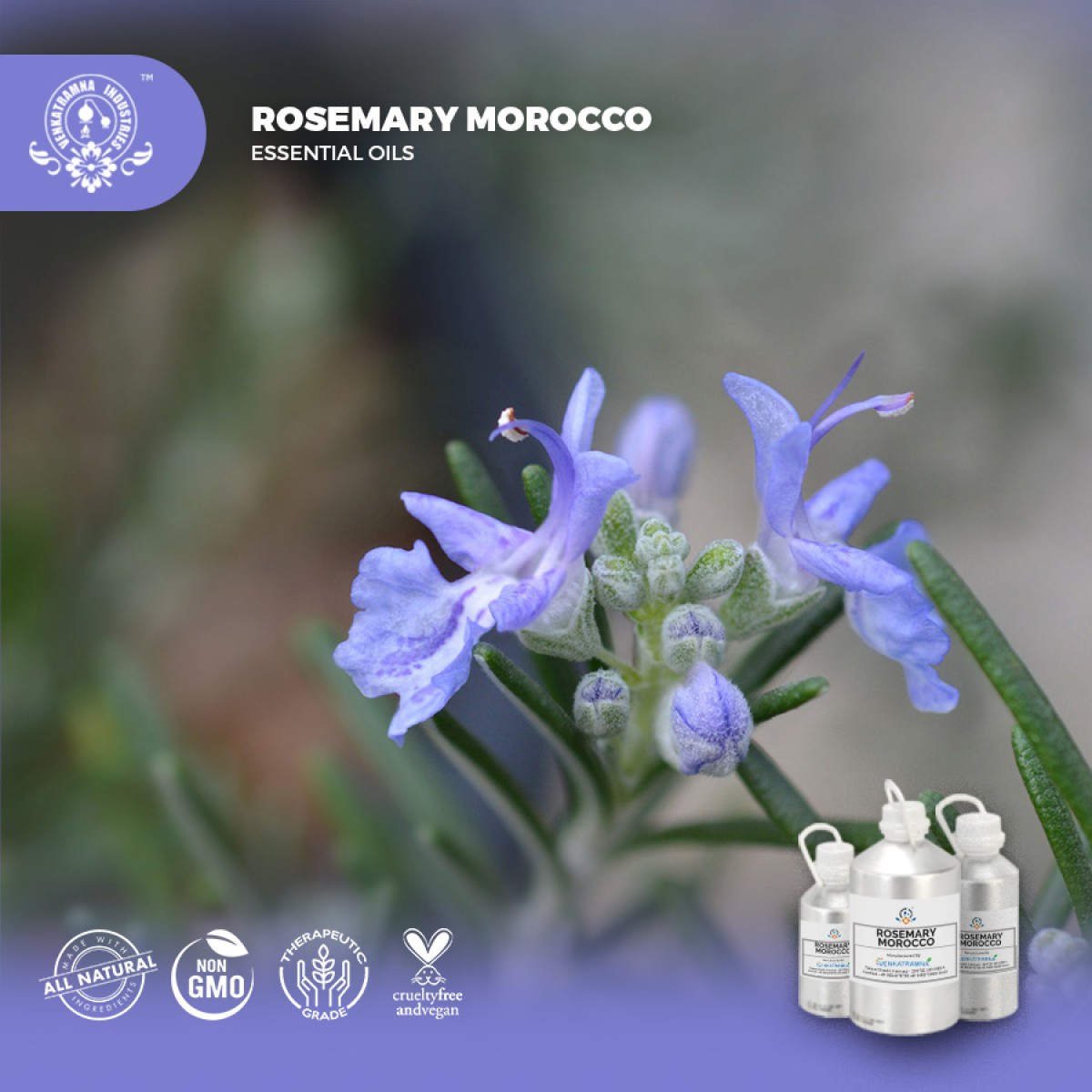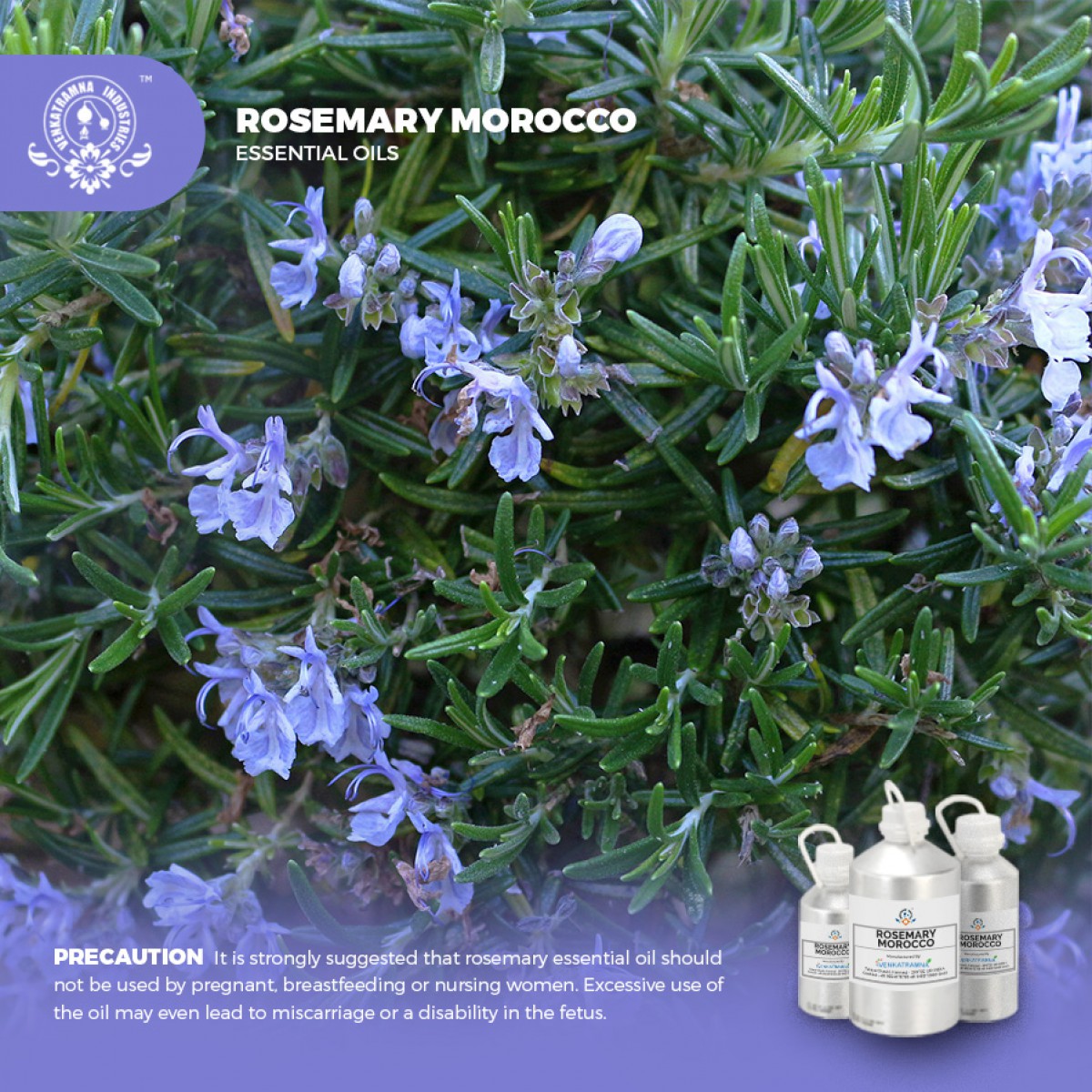Botanical Name: Rosmarinus officinalis Common name: Rosemary Plant Read More
|
Botanical Name: |
Rosmarinus officinalis |
|
Common name: |
Rosemary |
|
Plant
family: |
Lamiaceae |
|
Genus: |
Rosmarinus |
|
Appearance/Color: |
A thin, clear, colourless to pale yellow liquid. |
|
Odor: |
A top note with a strong aroma, Rosemary has a fresh, strong,
woody and herbal scent. |
|
Blends With: |
Basil, Bergamot, Cedarwood, Frankincens, Ginger, Lemon,
Orange and, Peppermint. |
|
Origin: |
Morocco |
|
Source: |
Herb |
|
Method
of Extraction: |
Steam Distillation |
Rosmarinus officinalis,
also known as rosemary, is an aromatic plant which belongs to the Lamiaceae
family and is native to the Mediterranean region. Rosemary essential oil is
produced by steam distillation from the flowering tips of the plant yielding a
colorless to pale yellow liquid with a strong, warm, woody, balsamic aroma.
Rosemary is an evergreen, usually erect, bushy shrub up to 2 m tall and wide. Stem indistinctly quadrangular, finely grey pubescent. Leaves opposite, tufted on the branches, sessile to short petiolate; blade linear, 1-5 cm x 1-2 mm, base attenuate, margin entire but revolute, apex obtuse, leathery, dark glossy sea-green and subglabrous above, white-felted tomentose beneath, aromatically fragrant when crushed. Inflorescence racemose, axillary, 5- to 10-flowered, 0.5-2.5 cm long, terminating short lateral branches; pedicel 2-5 mm long; calyx campanulate, 2-lipped, 5-6 mm long, densely stellate tomentose, upper lip small and 3-dentate, lower lip 2-lobed; corolla tubular, 2-lipped,10-13 mm long, pale blue or blue (seldom white), upper lip erect or recurved, 2-lobed, ovate, about 4 mm long, lower lip 3-lobed, about 7 mm long, with large concave middle lobe; 2 anterior stamens perfect, 7-8 mm long, ascending under the base of the upper lip, 2 posterior stamens reduced to hardly visible staminodes; pistil with deeply 4-partite ovary, style incurved, 1.5 cm long ending into 2 short, unequal branches with stigma. Fruit composed of 4 sub-globose to obovoid nutlets, about 2 mm long, glabrous and smooth.
DISCLAIMER
The complete range of conditions
or methods of use are beyond our control therefore we do not assume any
responsibility and expressly disclaim any liability for any use of this
product. Information contained herein is believed to be true and accurate however,
all statements or suggestions are made without warranty, expressed or implied,
regarding accuracy of the information, the hazards connected with the use of
the material or the results to be obtained from the use thereof. Compliance
with all applicable federal, state, and local laws and local regulations
remains the responsibility of the user.
The FDA has not evaluated the
statements on this website. No claims are made by Venkatramna Industries as to
the medicinal value of any products from vriaroma.com or by us. The information
presented here is for educating our customers about the traditional uses of
essential oils and is not intended to diagnose, treat, cure, or prevent any
disease. You are responsible for understanding the safe application of these products.
If you have any questions, please call or email us for further information.
As per NAHA guidelines, New Directions Aromatics
(NDA) does not recommend the ingestion of essential oils. It is imperative to
consult a medical practitioner before using Essential Oils for therapeutic
purposes. Pregnant and nursing women and those taking prescription drugs are
especially advised not to use this product without the medical advice of a
physician. The oil should always be stored in an area that is inaccessible to
children, especially those under the age of 7.
Rosemary is widely cultivated for
culinary and medicinal use. It is used in a wide variety of dishes, including
as a meat seasoning (lamb, poultry), to add flavor to soups and vegetables, and
in fruit salads, dressings, and stuffings. As reflected by the
name officinalis, it is known as a medicinal herb, with a long
history of use in the West, including nervous system ailments. Queen
Isabella of Hungary in the fourteenth century used rosemary to treat gout and
rosemary has been burned in sick rooms as a disinfectant. Its aromatic
properties are used to scent cosmetics.
Rosemary has been used medicinal
for long time. Hungary water, an alcohol-based perfume involving distilled
fresh rosemary, was traditionally believed to have been first prepared for the
Queen of Hungary in the fourteenth century to "renovate vitality of paralyzed
limbs" and to treat gout. It was used externally and prepared by mixing
fresh rosemary tops into spirits of wine or brandy. It has been used to ward
off the plague and burned in sick rooms as a disinfectant.
Long used medicinally in the
West, and called a "sovereign balm' by seventeenth-century herbalist
Nicholas Culpeper, it has been used as a circulatory stimulant (treatment of
blood pressure problems), antibacterial and antifungal oil, digestive
stimulant, liver tonic, reduction of excessive menstrual flow, and is said to
have cancer-inhibiting effects.
Rosemary has a very old
reputation for improving memory and has been used as a symbol for remembrance
(during weddings, war commemorations, and funerals) in Europe. Mourners would
throw it into graves as a symbol of remembrance for the dead. Greek scholars
would wear some of the pungent herb in their hair during study to increase
concentration.
Rosemary contains a number of
potentially biologically active compounds, including antioxidants such as carnosic
acid and rosmarinic acid. Other bioactive compounds include caffeic acid,
ursolic acid, betulinic acid, rosmaridiphenol, and rosmanol. The results of a
study suggest that carnosic acid, found in rosemary, may shield
the brain from free radicals, lowering the risk of strokes and
neurodegenerative diseases like Alzheimer's
Rosemary essential oil is often
an ingredient in bath salts, bath oils, liniments, gels and ointments. It can
also be found in cosmetic products such as lavender water, cologne water and as
fragrance in soaps. The essential oil of rosemary is widely used for hair care
as it nourishes the hair, promotes hair growth and helps against dandruff. It
is also recommended in hair-loss treatment as it is believed that it has
similar function to Minoxidil, an antihypertensive vasodilator medication,
which revitalizes hair follicles that are damaged. Rosemary oil widens blood
vessels and opens them and makes blood and nutrients more available to the
follicles which are then stimulated into producing new hair. In 2015, one study
conducted on patients with pattern hair loss (androgenic alopecia) compared the
effectiveness of rosemary oil vs. 2% Minoxidil in the treatment of adrogenic
alopecia. It was discovered that rosemary oil was as effective as 2% Minoxidil
and that patients in the rosemary group experienced less side effects compared
to patients in the Minoxidil group.
COMMON
USAGE
·
Aids in digestion
·
Hair care
·
Improves oral health
·
Skin care
·
Improves cognitive function
·
Relieves stress
·
Boosts immune system
·
Relieves pain
·
Removes bad odor
·
Prevents STDs
·
Treats respiratory problems
Ingredients:
|
S.No |
Key Constituents |
Strength (%) |
|
1 |
a-pinene |
24.0-28.5 |
|
2 |
Bornyl acetate |
11.5-14.3 |
|
3 |
1,8-cineole |
6.8-13.6 |
|
4 |
Camphor |
9.9-10.4 |
|
5 |
borneol |
5.0-8.4 |
|
6 |
Camphene |
5.9-7.0 |
|
7 |
Verbenone |
4.3-5.7 |
|
8 |
(P)-Limonene |
4.1-4.6 |
|
9 |
b-pinene |
2.2-2.9 |
|
10 |
b-myrcene |
1.7-2.4 |
|
11 |
p-cymene |
1.1-2.4 |
|
12 |
Linalool |
1.4-2.1 |
|
13 |
Terpinen-4-ol |
0.7-1.4 |
|
14 |
1-octen-3-ol |
0.8-1.2 |
Safety Summary
·
Hazards May be neurotoxic, based on
camphor content
·
Contraindications Do not apply to or near
the face of infants or children.
Organ Specific Effects
·
Adverse skin reactions: Undiluted
rosemary oil was moderately irritating to rabbits; tested at 10% on 25
volunteers it was neither irritating nor sensitizing; it is non-phototoxic. In
a study of 200 consecutive dermatitis patients, none were sensitive to 2%
rosemary oil on patch testing.
·
Cardiovascular effects: In normal
rabbits, 25 mg/kg im rosemary oil produced 20–55% increases in plasma glucose
levels after 60–120 minutes, and a 30% decrease in serum insulin levels.
Despite being contraindicated for people with high blood pressure in several
aromatherapy books there is no evidence that rosemary oil is hypertensive.
·
Reproductive toxicity: The low
reproductive toxicity of camphor, 1,8-cineole, a-pinene, b-myrcene and
(þ)-limonene suggest that most rosemary oils are not hazardous in pregnancy.
However, bornyl acetate and verbenone have not been studied.
Systemic Effects
·
Acute toxicity: Rosemary oil acute oral
LD50 in rats 5 mL/kg; acute dermal LD50 in rabbits >10 mL/kg. Rosemary oil
was not significantly cytotoxic to cultured human umbilical vein endothelial
cells. Camphor is potentially neurotoxic and may be more toxic in humans than
in rodents. Camphor minimum LD50 is1.7 g/kg in rats. 1,8-Cineole has been
reported to cause serious poisoning in young children when accidentally
instilled into the nose.
·
Antioxidant/ pro-oxidant activity : Rosemary
oil showed high antioxidant activity as a DPPH radical scavenger and against
lipid peroxidation. A rosemary oil showed high antioxidant activity in the same
two assays.
·
Carcinogenic/anticarcinogenic potential: Orally
administered rosemary oil was hepatoprotective in rats and antimutagenic in
Swiss mice. The antimutagenic dose of 1,100 mg/kg/day for seven days prevented
the formation of micronuclei. In a similar study, there was a significant
increase in micronuclei in Swiss mice given a single dose of 1,000 or 2,000
mg/kg, but there was no genotoxicity in a group on 300 mg/kg. However, a comet
assay found all three doses to be genotoxic. Rosemary oil induced apoptosis in
human liver cancer cells.
·
Drug interactions: Given to male rats in
their diet at 0.5% for two weeks, rosemary oil selectively induced CYP2B1 and
CYP2B2 in rat liver. This high-dose regimen does not suggest a significant risk
of drug interaction.
·
Serious eye damage / irritation No
additional Data available.
·
Respiratory or skin sensitization No
additional data available.
·
Germ Cell Mutagenicity No additional data
available.
·
Reproductive toxicity No additional data
available.
·
STOT-single exposure No additional data
available.
·
STOT-repeated exposure No additional data
available.
·
Aspiration hazard: No additional data
available.
·
Photo-toxicity: No additional data
available.
·
Ecotoxicity: Toxic to aquatic life with long
lasting effects. The product must not be allowed to run into drains or
waterways.
·
Bioaccumulation: No data available
·
Mobility in soil: No data available
·
Persistence and degradability: No data available
·
PBT and vPvB assessment: No data available
Avoid direct
exposure into water streams and ground water sources.





 MSDS-Rosemary.pdf
MSDS-Rosemary.pdf




